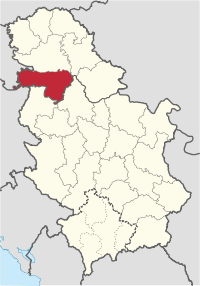Srem District
| Srem District Sremski okrug Сремски округ |
|
|---|---|
| District of Serbia | |
 Location of the Srem District within Serbia |
|
| Country |
|
| Province | Vojvodina |
| Administrative center | Sremska Mitrovica |
| Government | |
| • Commissioner | Dušanka Nuleši (acting) |
| Area | |
| • Total | 3,486 km2 (1,346 sq mi) |
| Population (2011 census) | |
| • Total | 312,278 |
| • Density | 90/km2 (230/sq mi) |
| ISO 3166 code | RS-07 |
| Municipalities | 6 and 1 city |
| Settlements | 109 |
| - Cities and towns | 7 |
| - Villages | 102 |
| Website | www |
The Srem District (Serbian: Сремски округ, Sremski okrug, pronounced [srɛ̂ːmskiː ôkruːɡ]) is one of seven administrative districts of the autonomous province of Vojvodina, Serbia. It lies in the geographical regions of Syrmia and Mačva. According to the 2011 census results, it has a population of 312,278 inhabitants. The administrative center is the city of Sremska Mitrovica.
In Serbian, the district is known as Sremski okrug (Сремски округ), in Croatian as Srijemski okrug, in Hungarian as Szerémségi Körzet, in Slovak as Sriemskí okres, in Rusyn as /Сримски окрух/, and in Romanian as Districtul Srem.
In the 3rd-5th century, the city of Sirmium (present-day Sremska Mitrovica) was a capital of Pannonia Secunda Roman province and in the 6th century it was a capital of Byzantine Pannonia. In the 7th century, during Avar administration, the area was ruled by Bulgar local ruler Kuber, while in the 11th century, it was ruled by independent Bulgarian-Slavic duke Sermon. In the 11th century, it was part of the Byzantine Theme of Sirmium.
...
Wikipedia
